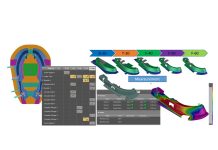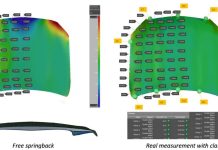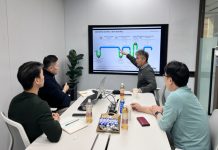Establishing Value Engineering Software Brings Supply Chain Cost Efficiency
In this blog post, we first explore how implementing a rapid value engineering system at the early stage of a car project has enabled one of our OEMs to drive early decisions thanks to improved cost predictability. A project’s “go/no-go” decisions are now based on accurate data generated by value engineering software systems. By extension, the OEM’s second project stage of supplier negotiations is now guided by transparent and reliable method plans that draw upon cost databases. This post covers a “before and after AutoForm implementation” comparison presented by Fabrizio Tinti.
Maintaining a transparent cost analysis and consistent over-time analysis, along with balancing internal costs and profits, can only be achieved using an automated software system. It supports eye-level negotiations and discussions that will avoid the escalation of subsequent issues. Reducing inefficiencies and data losses provides the key to future success and respectful relationships between OEM and suppliers.
The Problems of the Conventional Cost Analysis Method (“Before AutoForm Implementation”)
Manual cost analysis, usually generated on an Excel spreadsheet, cannot provide the transparency and consistency required of the associated calculations. Often, the planning (OEM) and bidding (Supplier) activities are performed without the benefit of 3D part geometry — and the information sketches in a 2D method plan are vulnerable to interpretation and uncertainty.
Cost efficiency is generally applied as a flat cut on the total figure, with the supplier left responsible for identifying where any cost improvements can be implemented. It’s nearly impossible to acquire a cost breakdown per operation or production item; instead, only macro numbers like part development, manufacturing cost, and material utilization are estimated.
Furthermore, when a supplier submits their quotation via Excel, their negotiations with the OEM mainly center around the final price. If the price is lower than the internal cost target defined by the OEM’s Purchasing Department, the supplier is added to the list of potential manufacturing Tier 1s and invited to a second phase of negotiations.

Fig. 1: Negotiations based on self-made Excel spreadsheets / costing solutions
In this second phase, the few suppliers that have been selected by the OEM are interviewed (the technical review might include Cost Engineering, Purchasing, and Stamping Technology experts) to determine their capacity to fulfill the order in the required time and within the prescribed quality.
This one-to-one phase is completed once the OEM finalizes their choice and submits the order.
From now on, if the supplier faces an issue during the manufacturing process, new negotiations are opened with the OEM, who assumes that unexpected issues were hidden during the bidding phase. Now, to overcome the issues and deliver the part on time, the supplier needs extra money (e.g., for part geometry changes, extra operations, extra tooling design changes, etc.), so they propose budget expansions to the OEM. Yet, this creates a new iteration loop of negotiating responsibility for these extra costs, which in turn generates extra costs to both supplier and OEM.
The OEM will probably investigate the formability issue with their Stamping Department and Cost Engineering team by requesting simulations and a delta cost analysis. The supplier, on the other hand, will be unable to accomplish the OEM’s request within the agreed cost and time target. Those hidden costs during the initial quotation period can have a big impact on the final cost and generate uncontrollable fluctuation of the defined targets — creating a knock-on effect over multiple years for the OEM. Neither player, having based their decision on Excel and experience alone, has the power or tools to strengthen their position and shift the final decision to their side. Negotiation can then become difficult and turn into a hard fight, possibly damaging future relations.
Consequently, suppliers can be forced to deliver what was requested at the agreed price, playing to the well-known political and natural law: ubi maior, minor cessat (“The weak capitulates before the strong”). As a direct consequence, during the next negotiation loop, the same supplier will try to recover that loss by asking for more money. In other situations, the supplier may decide to decrease the price below the earning limit just to cover the fixed costs and satisfy the OEM’s request. Their hope is to stay in the loop by consolidating their position as an efficient supplier and safeguard their inclusion in future tenders. The threat looms of the OEM moving their manufacturing activity to another country with cheaper hourly rates. These unpredictable negotiation results generate fluctuating costs and cash flows that do not support stable business planning.
Centering the negotiations around the target only (final figure of the total cost analysis) makes it extremely hard for OEMs to recognize whether the decisions are political in nature or genuinely driven by technical manufacturing costs. Enlisting experts in predicting feasibility analyses, tool designs and manufacturing is not enough to control the costs, even for carry-over parts. The fact that the same goods have already been produced in a different size does not guarantee the prevention of unpredictable costs the next time. The technical production cost analysis becomes skewed to a more complicated financial-political play between OEM and suppliers. The way this game is played can lead to the survival or death of the supplier as a business entity.
Taking Negotiations to a New Era of Planning and Bidding (“After AutoForm Implementation”)
Now, we report on a business case with our OEM customer where the Cost Engineering Group saw the potential to bring their cost figures under control and generate significant savings. By accepting AutoForm’s solution for costing analysis, the OEM could finally conduct bidding and planning analyses in a transparent and consistent way. The cost breakdown definition, plus the possibility to link the 3D method plan with feasibility simulations, represented a huge step in getting their costs under control.
The bottom-up calculation used in AutoForm-CostEstimator provides the ability to fully analyze the 3D part complexity and develop the proper method plan from the get-go. Tool design, directly linked to part geometry dimensions and press line selections, helps to determine all the cost drivers within a unique tool. There is also the advantage of incorporating robustness into the bidding analysis to strengthen the OEM’s position relative to supplier quoting.
Each costing item can be analyzed independently, and each action performed on tool design or the method plan has a direct consequence on final cost — all of which are impossible to see when quoting the part under the limited categories and macro numbers provided in Excel. A uniform and robust estimation is easy to defend and accept in negotiations against macro numbers based on someone’s experience.

Fig. 2: Negotiations based on unified AutoForm analysis/calculation
The introduction of AutoForm’s solution quickly changed the negotiation phase, drastically reducing the time involved in each session. For example, at the supplier tendering phase, the OEM can make well-founded decisions and optimize costs. In addition, having the ability to define different costing/tool construction standards and localize the hourly rates allows the OEM to increase efficiency in allocating decision drivers.
After accepting AutoForm’s solution for internal quoting and measuring tender for suppliers, the Cost Engineering Group decided to test the possibility of standardizing and expanding our software solution across the supply chain. The project’s aim was to establish a unique certified system for cost report exchanges, introducing a new level of transparency to the analysis.
This transparency is crucial to develop and sustain market growth potential and supply chain survival. Once the new quoting system was accepted by their suppliers, the OEM recognized new possibilities to develop the negotiation process further along the supply chain.
Looking at historical figures of the final price paid to suppliers and making some adjustments, the OEM was able to identify an income target for each supplier. After determining the accurate technical cost to produce a specific part, it was then possible to add a fixed percentage as pure supplier income through our software. Of course, customers and suppliers must agree in advance on the percentage value, but there are no longer hidden costs raised by suppliers once the commission has been assigned. The agreement is based on technically robust and transparent cost estimations that include the method plan, tool design, and material usage.
As such, no hidden costs can be unexpectedly proposed by the supplier during manufacturing. The OEM knows ahead of time what and how much is needed to manufacture a specific part and can sustain the predictability in the supply chain by realizing stable income over time. This means the suppliers will need to look critically at their organization and lean-down their procedures, workflow, and business management. Any remaining inefficiencies in the manufacturing process will reduce the value of that fixed percentage, making the business less profitable.
Summary: Transparency, Reliability, Trust
The introduction of a standardized software solution for the bidding phase has ushered in a new era for our OEM customer. Not only have both parties saved money, but the relationship between suppliers and the OEM is now based on transparency, reliability, and trust. Establishing a standard tool enables the comparison of method plans, tool cost estimations, part feasibility analyses, and material utilizations. This leads to effective negotiations and ultimately, successful production processes.













